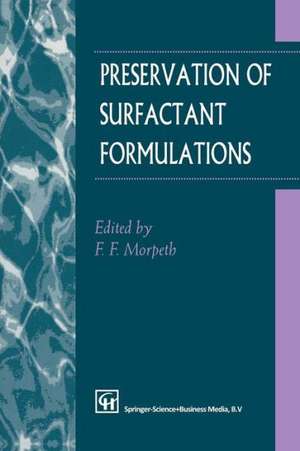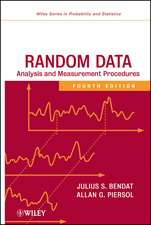Preservation of Surfactant Formulations
Editat de F. Morpethen Limba Engleză Paperback – 29 oct 2012
Preț: 393.74 lei
Nou
Puncte Express: 591
Preț estimativ în valută:
75.35€ • 78.22$ • 62.83£
75.35€ • 78.22$ • 62.83£
Carte tipărită la comandă
Livrare economică 22 martie-05 aprilie
Preluare comenzi: 021 569.72.76
Specificații
ISBN-13: 9789401042727
ISBN-10: 9401042721
Pagini: 392
Ilustrații: XVI, 373 p.
Dimensiuni: 155 x 235 x 21 mm
Greutate: 0.55 kg
Ediția:Softcover reprint of the original 1st ed. 1995
Editura: SPRINGER NETHERLANDS
Colecția Springer
Locul publicării:Dordrecht, Netherlands
ISBN-10: 9401042721
Pagini: 392
Ilustrații: XVI, 373 p.
Dimensiuni: 155 x 235 x 21 mm
Greutate: 0.55 kg
Ediția:Softcover reprint of the original 1st ed. 1995
Editura: SPRINGER NETHERLANDS
Colecția Springer
Locul publicării:Dordrecht, Netherlands
Public țintă
ResearchCuprins
1 An Introduction to Microbial Spoilage.- 1.1 Growth of Spoilage Microorganisms.- 1.2 Presence of a Suitable Carbon Source.- 1.3 Presence of Antimicrobial Components.- 1.4 Consequences of Microbial Spoilage.- References.- 2 Chemical Preservatives.- 2.1 Isothiazolinones.- 2.2 Other Nitrogen — Sulphur Compounds.- 2.3 Organobromine Compounds.- 2.4 Thiocyanates.- 2.5 Dithiocarbamates.- 2.6 Organoiodine Compounds.- 2.7 Aldehydes and Aldehyde-Release Agents.- 2.8 Phenols.- 2.9 Organic Acids and Salts.- 2.10 Mercury and other Inorganic Elements.- References.- 3 Control of Microbes through Plant Hygiene.- 3.1 Introduction.- 3.2 Design and Construction of the Premises.- 3.3 Control of Product Contact Surfaces.- 3.4 Control of Production Environment Air.- 3.5 Control of the Personnel Route of Contamination.- Further Reading.- References.- 4 An Introduction to Surfactants.- 4.1 Why are Surfactants of Interest?.- 4.2 How Surfactants Work.- 4.3 Surfactant Phenomena and Effects.- 4.4 Chemistry of Surfactants.- 4.5 Formulating with Surfactants.- 4.6 Some Final Thoughts.- Further Reading.- 5 Biodegradation of Surfactants.- 5.1 Introduction.- 5.2 Biodegradation of Anionic Surfactants.- 5.3 Biodegradation of Nonionic Surfactants.- 5.4 Biodegradation of Cationic Surfactants.- 5.5 Relevance to Biodeterioration.- References.- 6 Preservation of Agrochemicals.- 6.1 Introduction.- 6.2 Agrochemical Formulations.- 6.3 Surfactants for Agrochemicals.- 6.4 Preservatives for Agrochemicals.- References.- 7 Preservation of Personal Care Products.- 7.1 Introduction.- 7.2 Importance of Preservation.- 7.3 Preservative Efficacy Testing.- 7.4 Preservation Available for use.- 7.5 Conclusion.- Acknowledgements.- References.- 8 Preservation of Paint Formulations.- 8.1 Introduction.- 8.2 The Chemistry andManufacture of Paint.- 8.3 Consequences of Microbial Spoilage.- 8.4 Requirements for Microbial Growth.- 8.5 Typical Flora Associated with Paint Spoilage.- 8.6 The Problem with Solvent Free Systems: Spoilage.- 8.7 The Chemistry of Industrial Preservatives.- 8.8 Methods to Establish the Correct Biocide Level for Preservation.- 8.9 Implementing the Laboratory Report in Practice.- 8.10 Plant Sanitation and Hygiene Audits.- 8.11 When Spoilage Occurs.- 8.12 Implementing a HACCP Program.- 8.13 Summary.- References.- 9 Preservation of Aqueous-Based Synthetic Polymer Emulsions and Adhesive Formulations.- 9.1 General Introduction.- 9.2 Aqueous-Based Synthetic Polymer Emulsions.- 9.3 Adhesive Formulations.- 9.4 Microbial Spoilage of Polymer Emulsions and Adhesives.- 9.5 Prevention and Control of Microbial Spoilage in Polymer Emulsions and Adhesives.- 9.6 Preservation Strategies and Related issues Affecting Polymer Emulsions and Adhesives for the Next Millennium.- 9.7 Concluding Remarks.- References.- Further Reading.- 10 Preservation of Inorganic Systems.- 10.1 Introduction.- 10.2 Contamination Sources.- 10.3 Consequences of Microbiological Contamination.- 10.4 Sampling.- 10.5 Equipment Design.- 10.6 Exponential Growth.- 10.7 Microbiological Test Methods.- 10.8 Anaerobic Contamination.- 10.9 Microbiological Control.- 10.10 Biocides.- 10.11 Biocide Performance Testing.- 10.12 Biocide Addition Systems.- 10.13 Residual Biocide Testing.- 10.14 Working with the External Customer.- 10.15 Slurry made from Dry Material and Slurry Storage.- 11 Preservation of Metal Working Fluids.- 11.1 Introduction to Metalworking Fluids.- 11.2 Consequences of Metalworking Fluids Failure.- 11.3 Ranges and types of Metalworking Fluid.- 11.4 Maj or Surfactant Types used in Metalworking Fluids.- 11.5 Typesof Microorganism in Metalworking Fluids.- 11.6 Types of Preservative used in Metalworking Fluids.- 11.7 Testing Protocols used in Metalworking Fluid Preservative Selection.- 11.8 Summary.- References.- 12 Toxicology of Preservatives.- 12.1 Introduction.- 12.2 Preservatives in General use.- 12.3 Acute Toxicity.- 12.4 Skin and Eye Irritation.- 12.5 Skin and Respiratory Sensitization.- 12.6 Subacute and Chronic Toxicity including Carcinogenicity.- 12.7 Genetic toxicology.- 12.8 Reproductive and Developmental Effects.- 12.9 Environmental Considerations.- 12.10 Conclusion.- References.- 13 The Safe use of Preservatives.- References.- 14 Regulation of Preservatives in the USA.- 14.1 Introduction.- 14.2 Industrial Preservatives.- 14.3 Indirect Food Additives.- 14.4 Cosmetic Preservatives.- 14.5 Summary.- References.- 15 European Preservative Legislation.- 15.1 Introduction.- 15.2 Preservatives in the Oil Industry.- 15.3 Preservatives in the Paper Industry.- 15.4 The Proposed Biocidal Products Directory (93/239/03).- References.- Appendix 1 - Countries with Registration Procedures for Preservatives.- Appendix 2 - Typical Data Requirements for Preservatives use din the Off Shore Oil Drilling and Production Industry.





